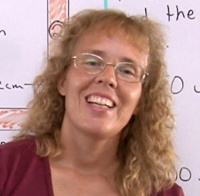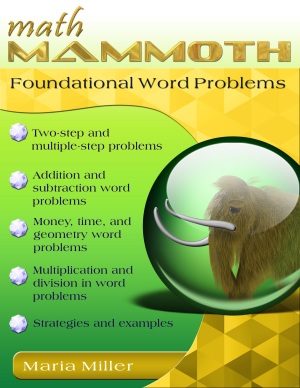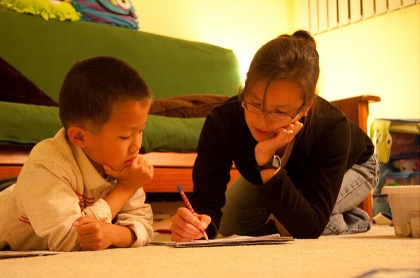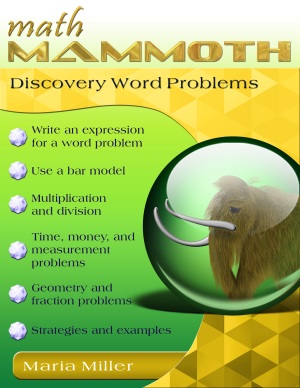
Hello!
In this article, I want to talk about MATH WORD PROBLEMS. They indeed give many children "problems", but that doesn't have to be!
Here's the outline of the article:
The problem
Have you ever noticed this kind of "recipe" for math lessons in many math books?
Explanation and examples. Numerical exercises. A few word problems.
In other words, the word problems are usually in the END of the lesson, and just a few. But worse... if the lesson is about topic X, then the word problems are usually about the topic X too!
Children might be learning about multi-digit multiplication, or subtraction, or dividing decimals. After the calculation exercises come some word problems, which oddly enough are solved by using the exact operation just practiced!
Worse YET... typically the word problems in elementary grades only have TWO numbers in them. So, even if you didn't understand a word in the problem, you might be able to do it. (The misguide to problem solving at the end of this article refers to this also.)
Just try: the following made-up problem is in FINNISH... and let's say it is found within a long division lesson. I assume now that you do NOT know Finnish — but can you solve it?
Drag your mouse over the white space below to see the translation (highlight it).
My thought is that over the years, when children are exposed to such lessons over and over again, they figure out that it's mentally less demanding to NOT even READ the problem too carefully! Why bother? Just take the two numbers, divide (or multiply, or add, or subtract) them, and that's it. They "learn" (intelligently) this unspoken rule:
It is no wonder that our students are not able to solve anything that's different from that routine!
The solution
How can you avoid this terrible situation?
Children simply need to be given good problems to solve. That way, they will get used to THINKING.
These good word problems should advance in difficulty over the grades, and foster children's logical thinking. ONE-step problems are adequate for 1st and 2nd grades, and then here and there mixed in with other types of problems.
In early elementary grades, one needs to mix up the (often one-step) word problems so that not all of them are solved by the operation just studied. I have done that often in my Math Mammoth books.
But children need to start solving MULTI-step problems as soon as they can, including even in 1st grade. (And yes, Math Mammoth books do include some two-step problems starting in 1st grade materials.)
Resources
The books listed below are especially aimed to help students in 4th-7th grades who have trouble with word problems and who need to “go back to the beginning”, so to speak, to learn to solve them.
Math Mammoth Foundational Word Problems requires knowledge of 3rd grade math (e.g. single-digit multiplication). The worksheets have examples and some instruction about common strategies for word problems. Students are often encouraged to write down the calculations they do.
See sample pages >Math Mammoth Discovery Word Problems is intended for students in 4th grade and above that need more practice with word problems. The problems require knowledge of 4th grade math, such as long division and long multiplication.
See sample pages >For a variety of word problems resources, check the list of problem solving resources at the end of this email.
Problems to ponder
Next, let's take a look at some PROBLEMS.![]() First, look at this example problem from a Russian fourth grade book:
First, look at this example problem from a Russian fourth grade book:
A similar problem is included in the 5th grade Singapore textbook:
Now, these are not anything spectacular. You can solve these types of problems for example by using a bar model (image from Math Mammoth grade 5 Light Blue series):

Or, you can solve them with arithmetic: simply take away the given difference from the total, then divide the remaining amount evenly, and lastly add the given difference to one person's part.
Yet in the U.S., these kind of problems are generally introduced in Algebra 1 — in ninth grade(!), AND they are only solved using algebraic means.
Here is another example, of which I remember feeling aghast, found in a modern U.S. algebra textbook:
Third-grade children should know multiplication well enough to quickly find that 6 and 7 fit the problem! Why use a "backhoe" (algebra) for a problem you can solve using a "small spade" (simple multiplication)!
I know some will argue and say, "Its purpose is to learn to set up an equation." But for that purpose I would use a bigger number and not 42. (Try 3422. ![]() ) Don't such simple problems in algebra books just encourage students to forget common sense and simple arithmetic?
) Don't such simple problems in algebra books just encourage students to forget common sense and simple arithmetic?
Another example, a 3rd grade problem from Russia:
You can draw a boy and a girl, draw two pockets for the boy, and one pocket for the girl. This visual representation easily solves the problem.
Here is an example of a Russian problem for grades 6-8:
(You can solve this in many different ways — and that is a often the case withe good word problems.)
So, once again, the only true way of learning to solve word problems is .... TO SOLVE LOTS OF THEM. They don't have to be real-life or involve awkward numbers (such as occur in real life). Realistic, complex problems might be good for a "spice", but not for the "main course". "Fantastic" (unreal) problems are fine.
One of my girls used to cherish the word problems in my Math Mammoth books MORE than the other kinds of problems. And the general consensus of the feedback I hear from Math Mammoth users is that once children get used to solving a variety of word problems, it's no longer a problem!
Some children, if not used to solving word problems, may need to start from the beginning — with a collection of simple one-step word problems (mixed up). But that's okay. They will learn! Our Foundational Word Problems book can get them started (at about 3rd grade level).
Lastly, a joke by Lynn Nordstrom:
Student's Misguide to Problem Solving
Rule 1: If at all possible, avoid reading the problem. Reading the problem only consumes time and causes confusion.
Rule 2: Extract the numbers from the problem in the order they appear. Be on the watch for numbers written in words.
Rule 3: If rule 2 yields three or more numbers, the best bet is adding them together.
Rule 4: If there are only 2 numbers which are approximately the same size, then subtraction should give the best results.
Rule 5: If there are only two numbers and one is much smaller than the other, then divide if it goes evenly -- otherwise multiply.
Rule 6: If the problem seems like it calls for a formula, pick a formula that has enough letters to use all the numbers given in the problem.
Rule 7: If the rules 1-6 don't seem to work, make one last desperate attempt. Take the set of numbers found by rule 2 and perform about two pages of random operations using these numbers. You should circle about five or six answers on each page just in case one of them happens to be the answer. You might get some partial credit for trying hard.
I hope your students do not fit the above joke.
Sources and further resources
 Math Mammoth Foundational Word Problems
Math Mammoth Foundational Word Problems
Math Mammoth Foundational Word Problems is a workbook intended for students in 3rd grade and above that need more practice with word problems. I especially aim to help students in 4th-7th grades who have trouble with word problems and who need to “go back to the beginning”, so to speak, to learn to solve them.
Math Mammoth Discovery Word Problems is intended for students in 4th grade and above that need more practice with word problems. The problems require knowledge of 4th grade math, such as long division and long multiplication.
Math Stars
Free problem-solving newsletters that include a nice mix of good problems that inspire curiosity. There is a set for each of the grades 1-8, with commentaries for teachers. I used them with all my children, and highly recommend them! The best is, they're free!
Problem Solving Decks
A free collection of problems for grades 1-8, originally published by the North Carolina State Board of Education.
 Math Puzzles and Brainteasers, Grades 6-8
Math Puzzles and Brainteasers, Grades 6-8
A book with over 300 delightful puzzles and problems that teach math and problem solving.
Ray's Arithmetic
Ray's Arithmetic is an old math book, full of word problems, starting from the simplest. It basically uses word problems to teach arithmetic. It is available FREE online.
3rd Grade Math Word Problems Worksheets
Look especially for the MIXED word problem worksheets in this collection. The site offers word problem worksheets for all of the grades 1-5 (look in the menu).

Challenge Math For the Elementary and Middle School Student
For children in grades 4-7. Contains 20 chapters with instruction and problems at three levels of difficulty.
Mixed operations word problem worksheets
These are all one-step problems but useful for grades 3-4 students who need such practice.
National Math Festival — collection of math newsletters that contain interesting & fun problems by themes such as "Math and Cats", "Math and Time", and "Math and Desserts".
By Maria Miller
Receive my monthly collection of math tips & resources directly in your inbox — and get a FREE Math Mammoth book!
You can unsubscribe at any time.
Math Mammoth TourConfused about the different options? Take a virtual email tour around Math Mammoth! You'll receive: An initial email to download your GIFT of over 400 free worksheets and sample pages from my books. Six other "TOURSTOP" emails that explain the important things and commonly asked questions concerning Math Mammoth curriculum. (Find out the differences between all these different-colored series!)This way, you'll have time to digest the information over one or two weeks, plus an opportunity to ask me personally about the curriculum. A monthly collection of math teaching tips & Math Mammoth updates (unsubscribe any time) We respect your email privacy.
Note: You will FIRST get an email that asks you to confirm your email address. If you cannot find this confirmation email, please check your SPAM/JUNK folder. |
"Mini" Math Teaching CourseThis is a little "virtual" 2-week course, where you will receive emails on important topics on teaching math, including:
- How to help a student who is behind You will also receive: A GIFT of over 400 free worksheets and sample pages from my books right in the very beginning.We respect your email privacy.
Note: You will FIRST get an email that asks you to confirm your email address. If you cannot find this confirmation email, please check your SPAM/JUNK folder. |
Maria's Math TipsEnter your email to receive math teaching tips, resources, Math Mammoth news & sales, humor, and more! I tend to send out these tips about once monthly, near the beginning of the month, but occasionally you may hear from me twice per month (and sometimes less often). Peek at the previous tips here. You will also receive:
We respect your email privacy.
|
|



